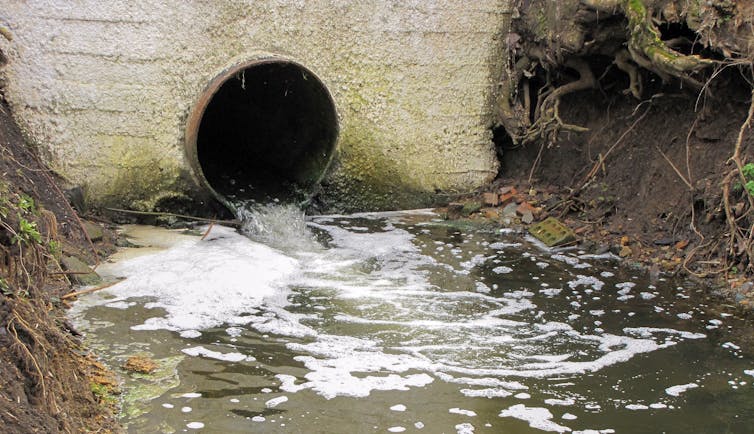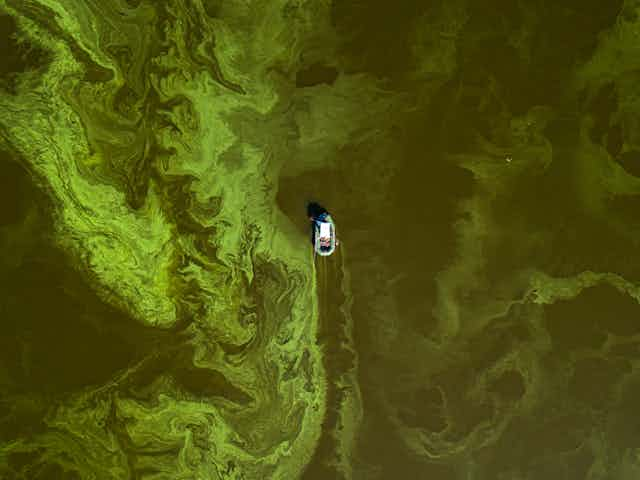This year has seen growing public concern over the state of England’s largest lake, Windermere. Campaigners, local residents and visitors have reported extensive blooms of blue-green algae at the site, with concern for its impact on health and ecology.
Somewhat misleadingly, blue-green algae are not actually algae. They are a type of bacteria, called cyanobacteria, which use sunlight to obtain energy and grow. There are many species of cyanobacteria. These can grow as single cells, too small to be seen with the naked eye, or in large clusters.
Cyanobacterial blooms are not new. They originated approximately 3 billion years ago and, through photosynthesis, they oxygenated the Earth’s atmosphere – helping to make other life possible. Cyanobacteria are found in a wide variety of freshwater habitats worldwide, including lakes such as Windermere.
The nutrients in wastewater, such as phosphorus, are critical for the formation of cyanobacterial blooms. The UK Centre for Ecology & Hydrology and the Freshwater Biological Association have carried out long-term monitoring of the lake. These data show that Windermere frequently experienced blooms in the past.
What causes a cyanobacterial bloom?
Blooms occur when cyanobacteria, usually present at low concentrations, multiply rapidly. This process is often invisible to lake users. However, during calm weather conditions, the cyanobacteria float to the surface and accumulate along the shoreline, where they are visible as “scums” or “slicks”.
High nutrient concentrations are needed to support large amounts of cyanobacteria. In Windermere, waste treatment sites combined with sewer overflows, run-off from nearby farmland and release from lake sediments can leak phosphorus into the lake.

Nitrogen concentrations can be important too. Some cyanobacteria can use dissolved nitrogen gas from the air to fuel their growth. This can give them a competitive advantage over other algae when nitrate concentrations are low.
Windermere is also warming rapidly. The lake’s mean surface water temperature has risen by 1.7°C over the past 70 years, while warm summer conditions this year have contributed to above average water temperatures for August. Fuelled by increasing nutrient concentrations, these warmer conditions have stimulated a rapid increase in cyanobacteria in Windermere.
As the climate continues to change, we can expect these weather conditions to become more frequent, and the risk of cyanobacterial blooms to increase.
Are these blooms harmful?
Cyanobacteria can produce potent toxins that can cause illness in humans and be fatal for animals.
However, not all blooms are toxic. This depends on both the species of cyanobacteria and the environmental conditions at the time. It is impossible to tell which blooms are toxic by sight and this can only be confirmed by laboratory analysis.
In addition to toxicity, the decomposition of dead cells from large blooms can reduce the oxygen content of the water. While this can reduce the habitat quality for aquatic wildlife, it can also alter the chemistry of the water and lake sediments. The reduction in oxygen concentration causes phosphorus that has been bound to iron in sediment to be released, which may stimulate further cyanobacterial growth.
Can we reduce levels of harmful algae?
To reduce the incidence of harmful blooms in lakes, the extreme weather conditions caused by climate change must be addressed. Mitigation of climate change can only come from coordinated international policy and action.
Locally, it is more feasible to manage the discharge of nutrients into lakes. However, both their source and pathway to the lake need to be established.
Further scientific evidence is required to determine what level of nutrient reduction is possible, and to guide measures to reduce the most significant sources. The Environment Agency has spent more than £700,000 over the past decade on tackling cyanobacterial blooms.
Another challenge lies in forecasting how lakes will respond to differing future climate change scenarios. We cannot necessarily return lakes such as Windermere to a pristine state because the climate, human activities, land use in the surrounding area and species populations at the lake have all changed.
The sustainable management of our ecosystems for people and nature will require further research to forecast what the future of our freshwater ecosystems could be if we act now and, crucially, what will happen if we fail to do so.

